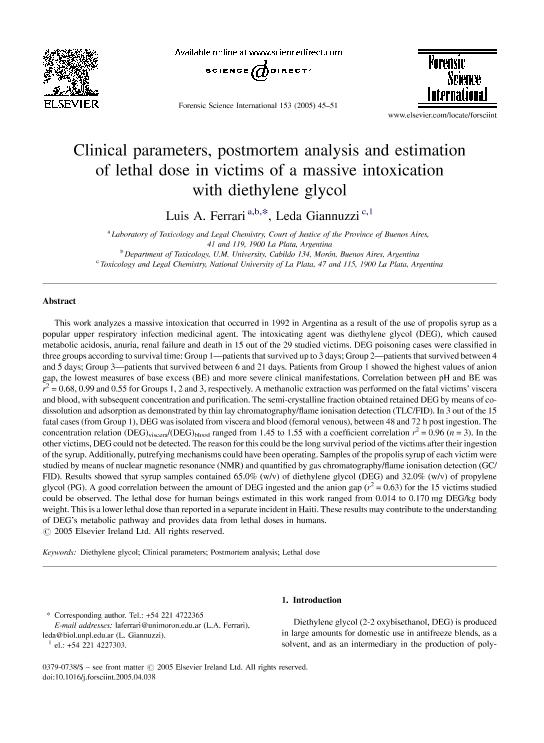Mostrar el registro sencillo del ítem
dc.contributor.author
Ferrari, Luis Alberto

dc.contributor.author
Giannuzzi, Leda

dc.date.available
2022-06-02T17:35:20Z
dc.date.issued
2005-10
dc.identifier.citation
Ferrari, Luis Alberto; Giannuzzi, Leda; Clinical parameters, postmortem analysis and estimation of lethal dose in victims of a massive intoxication with diethylene glycol; Elsevier Ireland; Forensic Science International; 153; 1; 10-2005; 45-51
dc.identifier.issn
0379-0738
dc.identifier.uri
http://hdl.handle.net/11336/158796
dc.description.abstract
This work analyzes a massive intoxication that occurred in 1992 in Argentina as a result of the use of propolis syrup as a popular upper respiratory infection medicinal agent. The intoxicating agent was diethylene glycol (DEG), which caused metabolic acidosis, anuria, renal failure and death in 15 out of the 29 studied victims. DEG poisoning cases were classified in three groups according to survival time: Group 1?patients that survived up to 3 days; Group 2?patients that survived between 4 and 5 days; Group 3?patients that survived between 6 and 21 days. Patients from Group 1 showed the highest values of anion gap, the lowest measures of base excess (BE) and more severe clinical manifestations. Correlation between pH and BE was r2 = 0.68, 0.99 and 0.55 for Groups 1, 2 and 3, respectively. A methanolic extraction was performed on the fatal victims? viscera and blood, with subsequent concentration and purification. The semi-crystalline fraction obtained retained DEG by means of codissolution and adsorption as demonstrated by thin lay chromatography/flame ionisation detection (TLC/FID). In 3 out of the 15 fatal cases (from Group 1), DEG was isolated from viscera and blood (femoral venous), between 48 and 72 h post ingestion. The concentration relation (DEG)viscera/(DEG)blood ranged from 1.45 to 1.55 with a coefficient correlation r2 = 0.96 (n = 3). In the other victims, DEG could not be detected. The reason for this could be the long survival period of the victims after their ingestion of the syrup. Additionally, putrefying mechanisms could have been operating. Samples of the propolis syrup of each victim were studied by means of nuclear magnetic resonance (NMR) and quantified by gas chromatography/flame ionisation detection (GC/FID). Results showed that syrup samples contained 65.0% (w/v) of diethylene glycol (DEG) and 32.0% (w/v) of propylene glycol (PG). A good correlation between the amount of DEG ingested and the anion gap (r2 = 0.63) for the 15 victims studied could be observed. The lethal dose for human beings estimated in this work ranged from 0.014 to 0.170 mg DEG/kg body weight. This is a lower lethal dose than reported in a separate incident in Haiti. These results may contribute to the understanding of DEG?s metabolic pathway and provides data from lethal doses in humans.
dc.format
application/pdf
dc.language.iso
eng
dc.publisher
Elsevier Ireland

dc.rights
info:eu-repo/semantics/openAccess
dc.rights.uri
https://creativecommons.org/licenses/by-nc-sa/2.5/ar/
dc.subject
DIETHYLENE GLYCOL
dc.subject
POSTMORTEM TISSUE
dc.subject
CLINICAL PARAMETERS
dc.subject
PROPOLIS SYRUP
dc.subject.classification
Alimentos y Bebidas

dc.subject.classification
Otras Ingenierías y Tecnologías

dc.subject.classification
INGENIERÍAS Y TECNOLOGÍAS

dc.title
Clinical parameters, postmortem analysis and estimation of lethal dose in victims of a massive intoxication with diethylene glycol
dc.type
info:eu-repo/semantics/article
dc.type
info:ar-repo/semantics/artículo
dc.type
info:eu-repo/semantics/publishedVersion
dc.date.updated
2022-05-12T16:32:53Z
dc.identifier.eissn
1872-6283
dc.journal.volume
153
dc.journal.number
1
dc.journal.pagination
45-51
dc.journal.pais
Irlanda

dc.description.fil
Fil: Ferrari, Luis Alberto. Universidad de Morón. Facultad de Ciencias Exactas, Químicas y Naturales; Argentina
dc.description.fil
Fil: Giannuzzi, Leda. Provincia de Buenos Aires. Gobernación. Comisión de Investigaciones Científicas. Centro de Investigación y Desarrollo en Criotecnología de Alimentos. Consejo Nacional de Investigaciones Científicas y Técnicas. Centro Científico Tecnológico Conicet - La Plata. Centro de Investigación y Desarrollo en Criotecnología de Alimentos. Universidad Nacional de La Plata. Facultad de Ciencias Exactas. Centro de Investigación y Desarrollo en Criotecnología de Alimentos; Argentina
dc.journal.title
Forensic Science International

dc.relation.alternativeid
info:eu-repo/semantics/altIdentifier/url/https://www.sciencedirect.com/science/article/abs/pii/S0379073805002070
dc.relation.alternativeid
info:eu-repo/semantics/altIdentifier/doi/http://dx.doi.org/10.1016/j.forsciint.2005.04.038
Archivos asociados
